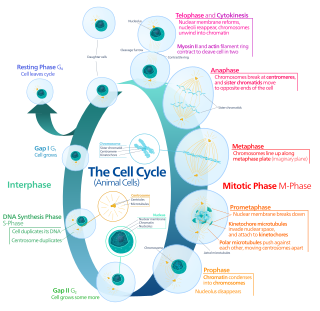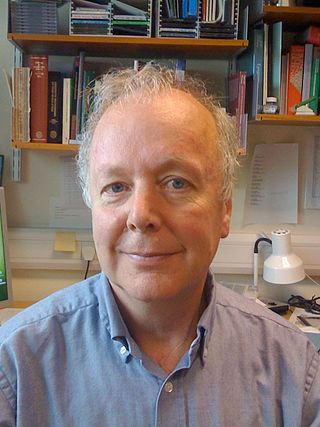Related Research Articles

The centromere links a pair of sister chromatids together during cell division. This constricted region of chromosome connects the sister chromatids, creating a short arm (p) and a long arm (q) on the chromatids. During mitosis, spindle fibers attach to the centromere via the kinetochore.

Mitosis is a part of the cell cycle in which replicated chromosomes are separated into two new nuclei. Cell division by mitosis is an equational division which gives rise to genetically identical cells in which the total number of chromosomes is maintained. Mitosis is preceded by the S phase of interphase and is followed by telophase and cytokinesis, which divide the cytoplasm, organelles, and cell membrane of one cell into two new cells containing roughly equal shares of these cellular components. The different stages of mitosis altogether define the mitotic phase of a cell cycle—the division of the mother cell into two daughter cells genetically identical to each other.

The spindle checkpoint, also known as the metaphase-to-anaphase transition, the spindle assembly checkpoint (SAC), the metaphase checkpoint, or the mitotic checkpoint, is a cell cycle checkpoint during metaphase of mitosis or meiosis that prevents the separation of the duplicated chromosomes (anaphase) until each chromosome is properly attached to the spindle. To achieve proper segregation, the two kinetochores on the sister chromatids must be attached to opposite spindle poles. Only this pattern of attachment will ensure that each daughter cell receives one copy of the chromosome. The defining biochemical feature of this checkpoint is the stimulation of the anaphase-promoting complex by M-phase cyclin-CDK complexes, which in turn causes the proteolytic destruction of cyclins and proteins that hold the sister chromatids together.

A kinetochore is a disc-shaped protein structure associated with duplicated chromatids in eukaryotic cells where the spindle fibers attach during cell division to pull sister chromatids apart. The kinetochore assembles on the centromere and links the chromosome to microtubule polymers from the mitotic spindle during mitosis and meiosis. The term kinetochore was first used in a footnote in a 1934 Cytology book by Lester W. Sharp and commonly accepted in 1936. Sharp's footnote reads: "The convenient term kinetochore has been suggested to the author by J. A. Moore", likely referring to John Alexander Moore who had joined Columbia University as a freshman in 1932.

Aurora kinase B is a protein that functions in the attachment of the mitotic spindle to the centromere and in cytokinesis.

Centromere protein A, also known as CENPA, is a protein which in humans is encoded by the CENPA gene. CENPA is a histone H3 variant which is the critical factor determining the kinetochore position(s) on each chromosome in most eukaryotes including humans.

Kinetochore protein NDC80 homolog is a protein that in humans is encoded by the NDC80 gene.

Centromere-associated protein E is a protein that in humans is encoded by the CENPE gene.

Centromere protein C 1 is a protein that in humans is encoded by the CENPC1 gene.

Centromere protein H is a protein that in humans is encoded by the CENPH gene. It is involved in the assembly of kinetochore proteins, mitotic progression and chromosome segregation.

Sir Adrian Peter Bird is a British geneticist and Buchanan Professor of Genetics at the University of Edinburgh. Bird has spent much of his academic career in Edinburgh, from receiving his PhD in 1970 to working at the MRC Mammalian Genome Unit and later serving as director of the Wellcome Trust Centre for Cell Biology. His research focuses on understanding DNA methylation and CpG islands, and their role in diseases such as Rett syndrome.
Ulrich K. Laemmli, real name Lämmli, is a Professor in the biochemistry and molecular biology departments at University of Geneva. He is known for the refinement of SDS-PAGE, a widely used method for separating proteins based on their electrophoretic mobility. His paper describing the method is among the most cited scholarly journal articles of all time. His current research involves studying the structural organization of nuclei and chromatin within the cell.
In molecular biology, the protein domain named the Shugoshin N-terminal coiled-coil region is a domain found on the N-terminal region of the Shugoshin protein in eukaryotes. It has a role in attaching to the kinetochores, structures on the chromatids where microtubules attach. Shugoshin has a conserved coiled-coil N-terminal domain and a highly conserved C-terminal region. Shugoshin is a crucial target of Bub1 kinase that plays a central role in the cohesion of chromosomes during cell division.

Steve David Macleod Brown is a British geneticist who is director of the Medical Research Council (MRC) Mammalian Genetics Unit, MRC Harwell at Harwell Science and Innovation Campus, Oxfordshire, a research centre on mouse genetics. In addition, he leads the Genetics and Pathobiology of Deafness research group.

Wendy Anne Bickmore is a British genome biologist known for her research on the organisation of genomic material in cells.

Neocentromeres are new centromeres that form at a place on the chromosome that is usually not centromeric. They typically arise due to disruption of the normal centromere. These neocentromeres should not be confused with “knobs”, which were also described as “neocentromeres” in maize in the 1950s. Unlike most normal centromeres, neocentromeres do not contain satellite sequences that are highly repetitive but instead consist of unique sequences. Despite this, most neocentromeres are still able to carry out the functions of normal centromeres in regulating chromosome segregation and inheritance. This raises many questions on what is necessary versus what is sufficient for constituting a centromere.

Robin Campbell Allshire is a British academic who is Professor of Chromosome Biology at University of Edinburgh and a Wellcome Trust Principal Research Fellow. His research group at the Wellcome Trust Centre for Cell Biology focuses on the epigenetic mechanisms governing the assembly of specialised domains of chromatin and their transmission through cell division.
Julian Blow is a molecular biologist, Professor of Chromosome Maintenance, and also the Dean of the School of Life Sciences, University of Dundee, Scotland.

Tim J. Yen is an American molecular biologist and cancer biologist. Yen held the rank of Professor and in 2023, became Emeritus at Fox Chase Cancer Center in Philadelphia, Pennsylvania. Yen is known for pioneering work in the field of mitosis.
In biology, the chromosome scaffold is the backbone that supports the structure of the chromosomes. It is composed of a group of non-histone proteins that are essential in the structure and maintenance of eukaryotic chromosomes throughout the cell cycle. These scaffold proteins are responsible for the condensation of chromatin during mitosis.
References
- 1 2 "The EMBO Pocket Directory" (PDF). European Molecular Biology Organization. Archived from the original (PDF) on 16 March 2015.
- ↑ Bill Earnshaw publications indexed by the Scopus bibliographic database. (subscription required)
- ↑ Bill Earnshaw publications from Europe PubMed Central
- ↑ "Prof Bill Earnshaw, FRSE, FMedSci: Professor of Chromosome Dynamics, School of Biological Sciences". University of Edinburgh. Archived from the original on 10 June 2015.
- ↑ Lazebnik, Y. A.; Kaufmann, S. H.; Desnoyers, S; Poirier, G. G.; Earnshaw, W. C. (1994). "Cleavage of poly(ADP-ribose) polymerase by a proteinase with properties like ICE". Nature. 371 (6495): 346–7. Bibcode:1994Natur.371..346L. doi:10.1038/371346a0. PMID 8090205. S2CID 4315478.
- ↑ Earnshaw, W. C.; Martins, L. M.; Kaufmann, S. H. (1999). "Mammalian caspases: Structure, activation, substrates, and functions during apoptosis". Annual Review of Biochemistry. 68: 383–424. doi:10.1146/annurev.biochem.68.1.383. PMID 10872455.
- ↑ Kaufmann, S. H.; Earnshaw, W. C. (2000). "Induction of apoptosis by cancer chemotherapy". Experimental Cell Research. 256 (1): 42–9. doi:10.1006/excr.2000.4838. PMID 10739650.
- 1 2 "Prof Bill Earnshaw, FRSE, FMedSci". University of Edinburgh. Archived from the original on 16 May 2012.
- ↑ Bill Earnshaw – Biological Sciences on Vimeo, University of Edinburgh
- ↑ Earnshaw, William Charles (1977). The Structure of Bacteriophage p22 and its Assembly Intermediates (PhD thesis). Massachusetts Institute of Technology.
- ↑ Earnshaw, W; King, J (1978). "Structure of phage P22 coat protein aggregates formed in the absence of the scaffolding protein". Journal of Molecular Biology. 126 (4): 721–47. doi:10.1016/0022-2836(78)90017-7. PMID 370407.
- ↑ Earnshaw, W. C.; Hendrix, R. W.; King, J (1979). "Structural studies of bacteriophage lambda heads and proheads by small angle X-ray diffraction". Journal of Molecular Biology. 134 (3): 575–94. doi:10.1016/0022-2836(79)90368-1. PMID 161330.
- ↑ Earnshaw, W. C.; King, J; Harrison, S. C.; Eiserling, F. A. (1978). "The structural organization of DNA packaged within the heads of T4 wild-type, isometric and giant bacteriophages". Cell. 14 (3): 559–68. doi:10.1016/0092-8674(78)90242-8. PMID 688382. S2CID 9738540.
- ↑ Earnshaw, W. C.; King, J; Eiserling, F. A. (1978). "The size of the bacteriophage T4 head in solution with comments about the dimension of virus particles as visualized by electron microscopy". Journal of Molecular Biology. 122 (2): 247–53. doi:10.1016/0022-2836(78)90040-2. PMID 682194.
- ↑ Earnshaw, W. C.; Honda, B. M.; Laskey, R. A.; Thomas, J. O. (1980). "Assembly of nucleosomes: The reaction involving X. Laevis nucleoplasmin". Cell. 21 (2): 373–83. doi:10.1016/0092-8674(80)90474-2. PMID 7407918. S2CID 25210558.
- ↑ Laskey, R. A.; Earnshaw, W. C. (1980). "Nucleosome assembly". Nature. 286 (5775): 763–7. Bibcode:1980Natur.286..763L. doi:10.1038/286763a0. PMID 6250082. S2CID 4373003.
- ↑ Earnshaw, W. C.; Laemmli, U. K. (1984). "Silver staining the chromosome scaffold". Chromosoma. 89 (3): 186–92. doi:10.1007/bf00294997. PMID 6201324. S2CID 19757611.
- ↑ Earnshaw, W. C.; Laemmli, U. K. (1983). "Architecture of metaphase chromosomes and chromosome scaffolds". The Journal of Cell Biology. 96 (1): 84–93. doi:10.1083/jcb.96.1.84. PMC 2112267 . PMID 6826654.
- ↑ Earnshaw, W. C.; Sullivan, K. F.; Machlin, P. S.; Cooke, C. A.; Kaiser, D. A.; Pollard, T. D.; Rothfield, N. F.; Cleveland, D. W. (1987). "Molecular cloning of cDNA for CENP-B, the major human centromere autoantigen". The Journal of Cell Biology. 104 (4): 817–29. doi:10.1083/jcb.104.4.817. PMC 2114438 . PMID 2435739.
- ↑ Bergmann, Jan H. (2010). Hacking the centromere chromatin code : dissecting the epigenetic regulation of centromere identity (PhD thesis). University of Edinburgh. hdl:1842/4670. EThOS uk.bl.ethos.563000.

- ↑ Petruti-Mot, Anca (2000). Genetic and functional analysis of topoisomerase II in vertebrates (PhD thesis). University of Edinburgh. hdl:1842/8985. EThOS uk.bl.ethos.615334.

- ↑ Ribeiro, Susana Abreu (2010). Structural and functional mapping of the vertebrate centromere (PhD thesis). University of Edinburgh.
- ↑ Wood, Laura Charlotte (2014). Understanding kinetochore dependency pathways using vertebrate conditional knockout cell lines and quantitative proteomics. ed.ac.uk (PhD thesis). University of Edinburgh. hdl:1842/8964. EThOS uk.bl.ethos.615458.

- ↑ Xu, Zhenjie (2009). Cellular and molecular analysis of chromosomal passenger complex in vertebrate cells (PhD thesis). University of Edinburgh.
- ↑ Zuleger, Nikolaj (2012). Inner nuclear membrane proteins : targeting and influence on genome organization (PhD thesis). University of Edinburgh.
- ↑ "Professor William Earnshaw FMedSci FRS". London: Royal Society. Archived from the original on 23 September 2015.
- ↑ "Professor William Earnshaw FMedSci FRS". London: The Royal Society. Archived from the original on 10 June 2015.